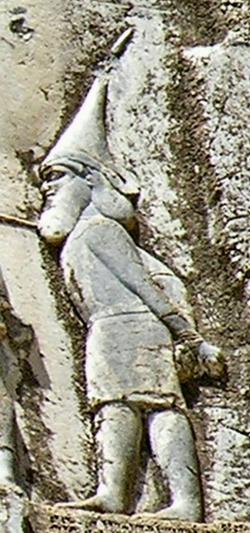The proto-Slavic warrior in Europe: The Scythians, Sarmatians and Lekhs
 Scytyjski władca Skunkha (Skuncza – inskrypcja Behistun)
Scytyjski władca Skunkha (Skuncza – inskrypcja Behistun)
Pages
1-14
Contributors
author
- University of Rzeszow, Rzeszow (Poland)
author
- University of Szczecin, Szczecin (Poland)
Identifiers
YADDA identifier
bwmeta1.element.desklight-5b06911c-5fe9-4887-8cb0-1c935064908d
Abstracts
Background. The frame of reference for this research is provided by a cross-disciplinary approach to the anthropology of martial arts. The results of research into genetics, linguistics, anthropology, general ancient and medieval history, and hoplology have provided a check on the hypotheses and supported the logical explanation backing the ideas presented in this paper. Aim. The authors pose questions concerning the Slavs, the Scythians and Sarmatians, and their systems of warfare and their relationship to today’s Lekhs. The following hypothesis is presented: if the Scythians, Aryans and Slavs came from a single genetic root, then today’s Slavs, especially the Western and Eastern ones, are their descendants, but the relationship is not limited merely to biology. Results. The Scythians and Sarmatians made a great contribution to the development of the art of war. This applies particularly to the use of horses and the tactical use of cavalry and archery. Their warrior- ethos has been preserved in the legends, symbols and traditions of the Polish (Lekh) nobility. Historic genetic material – also indicates the presence of ancestors of the Slavs in Central Europe from c2700 BCE. The languages of the Aryans and Scythians were closely related to the Slavic languages, and known as proto-Slavonic. However Scythians were speaking apparently different languages. Another proof of kinship may be the similarity between the iconography of the coats of arms of the Polish nobility and Scythian ornamentation. Conclusions. A genealogy based on the presence of specific haplogroups on the Y chromosome indicates a lack of foreign genetic influences, suggesting the autochtonicity of the Slavs in the lands between the Oder and the Dnieper Rivers, between the Baltic Sea and the Carpathian Mountains. The original Scythians were probably carriers of haplogroup R1a, with the subgroups R1a1a1b2 (created as a result of mutation F992/S202/Z93) and R1a1a1 (created as a result of the emergence of mutation M417) most widely represented. The direct or indirect descendants of the early Scythians, or Proto-Slavs (the commonly-agreed terms) are, in particular the Poles, characterized by the highest concentration of the R1a1a1b1a1 haplogroup (M458/PF6241) and other Western Slavs, e.g. today’s Sorbs and Slovaks.
Perspektywę dla badań daje antropologia sztuk walki w ujęciu transdyscyplinarnym. Sprawdzenie hipotez i logiczne uzasadnienie stwierdzeń wyjaśniających zostało poparte wynikami badań z zakresu genetyki, językoznawstwa, antropologii kulturowej, historii powszechnej starożytnej i średniowiecznej, oraz hoplologii. Cel. Autorzy stawiają pytania o Prasłowian, Scytów i Sarmatów, o ich sztukę wojenną oraz ich relacje do dzisiejszych Lechitów. Stawiają hipotezę: Jeżeli Scytowie, Ariowie i Słowianie wyszli z jednego genetycznego pnia (nosicieli R1a1), to dzisiejsi Słowianie, zwłaszcza Zachodni i Wschodni, są ich potomkami, a pokrewieństwo nie ogranicza się do jedynie biologicznego. Wyniki poszukiwań. Scytowie i Sarmaci (prawdopodobni nosiciele haplogroupy R1a1) wnieśli wielki wkład w rozwój sztuki wojennej. Dotyczy to zwłaszcza użycia jazdy konnej i taktycznego wykorzystania konnicy, oraz łucznictwa. Ich etos wojowników został zachowany w legendach, symbolice i tradycji polskiej (lechickiej) szlachty. Pozostały też geny, świadczące o obecności przodków Słowian w Europie środkowej od ok. 2700 BC. Języki Ariów i Scytów były blisko pokrewne do języków słowiańskich, jako prasłowiańskie. Dodatkowym dowodem pokrewieństwa może być podobieństwo ikonografii polskich herbów szlacheckich do ornamentyki scytyjskiej. Wnioski. Genealogia wyprowadzona na podstawie obecności poszczególnych haplogrup w chromosomie Y wskazuje na brak obcych wpływów genetycznych, co sugeruje autochtoniczność Słowian na ziemiach między Odrą a Dnieprem, Bałtykiem a Karpatami. Pierwotni Scytowie byli prawdopodobnie nosicielami haplogrupy R1a, z najczęściej reprezentowanymi podgrupami R1a1a2 (powstała w konsekwencji mutacji Z93) i R1a1a1 (powstała w rezultacie pojawienia się mutacji M417). Bezpośredni lub pośredni potomkowie pierwotnych Scytów i Sarmatów, czyli Prasłowian (określenie umowne), to zwłaszcza Polacy (charakteryzujący się największą koncentracją haplogrupy R1a1a1) i inni Słowianie Zachodni (dzisiejsi Łużyczanie, Słowacy).
PDF całość: The proto-Slavic warrior in Europe The Scythians Sarmatians and Lekhs
